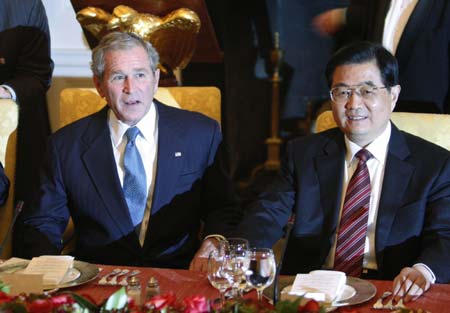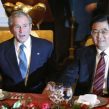
Beijing’s Stimulus Plan: Preemptive Crisis Management
Publication: China Brief Volume: 8 Issue: 22

China’s $586 billion (4 trillion yuan) stimulus package, which was announced before last weekend’s G20 Summit in Washington, has been hailed as indicative of Beijing’s commitment to stave off further bleeding from the global recession. World Bank Vice-President Justin Lin noted that the resuscitation effort would not only “make major contributions to China’s economic growth … but also become a catalyst for the export industries of other countries and help the world shake off recession earlier” (Xinhua News Agency, November 13). While most pump-priming measures require several months to take effect, there seems little doubt that hefty outlays in infrastructure and other areas will boost domestic demand and provide temporary relief by creating more jobs to accommodate China’s growing workforce. To convince their countrymen—and the global community—that China’s largest –ever save-the-market game plan will produce optimal results, however, the Chinese Communist Party (CCP) leadership has to answer questions ranging from whether the plan is affordable to whether the money will be well spent. There are also indications that given the unexpectedly sudden downturn in the domestic economy (industrial growth for October grew by 8.2 percent—the lowest rate in seven years), the Hu Jintao-Wen Jiabao administration is taking draconian steps to pre-empt social instability that’s being engendered by worsening unemployment (China Daily, November 13; AFP, November 13).
The main goal of this Keynesian new deal is to bao-ba (literal translation: save eight)—or maintain an 8 percent GDP growth rate in 2009 and 2010—by generating sufficient domestic demand to make up for dwindling exports to regions such as the United States and Europe. About $146.5 billion (1 trillion yuan) will be ploughed into infrastructure and energy-related projects—new highways, railways, electricity grids and nuclear plants—in both 2009 and 2010. Some $14.7 million (100 billion yuan) has already been earmarked for the rest of 2008: $3.7 million (25 billion yuan) will go into roads, railways and airports; $5 million (34 billion yuan) for rural infrastructure; $1.5 million (10 billion yuan) for subsidized housing, and $1.9 million (13 billion yuan) for medical and educational facilities. Moreover, tax rebates will be made available for thousands of export items even as corporate taxes are being slashed across the board. The Ministry of Finance clarified on November 14 that central coffers would only dole out $173.3 billion (1.18 trillion yuan), with the rest of the package, or $412.7 billion (2.82 trillion yuan), coming from local governments and enterprises (Xinhua News Agency, November 14; Ming Pao [Hong Kong], November 15). This has at least temporarily laid to rest fears that the central government will be saddled with excessive debt. While China enjoyed a small budgetary surplus last year, Western economists estimate the country’s total public debt at more than 60 percent of GDP. Due to the ongoing downturn, especially from the lackadaisical housing and stock markets, tax and other revenues for the central government in 2008 are expected to fall far short of the record $761.8 billion (5.2 trillion yuan) last year. Moreover, another part of the rescue plan—cutting profits taxes—will mean that the government will be collecting some $44.1 million (300 billion yuan) less revenue in the coming couple of years (South China Morning Post, November 12).
Of more immediate concern for economists and policy specialists is whether the new deal has been crafted to ensure that investments will go to areas and sectors that are most in need, or whether the injection of capital will produce the biggest multiplier effects. Even the traditionally docile official media are full of stories of hundreds of cadres from dozens of ministries and provinces knocking on the doors of the National Development and Reform Commission (NDRC)—the “super-ministry” charged with divvying up the stimulus pie—looking for a handout. “It’s not easy to implement investment plans of 100 billion yuan in 110 days,” said Xinhua Website commentator Wang Qing. “The stiffer the requirements, the more cool-headed central ministries and regional governments must be.” Wang added that officials must “avoid scrambling for the funds irrespective of objective conditions”—and that Beijing’s largesse should be not be showered on “vested interest groups.” Analysts have noted that previous resuscitation programs—such as the $95.6 million (650 billion yuan) campaign to revive the economies of the 11 western provinces that began in the late 1990s—have created large numbers of under-used highways, bridges, airports and railways in these outback regions. While such infrastructure building certainly created employment opportunities, it will take the government decades to recover the initial investment (Xinhua News Agency, November 13; New Beijing Post, November 13; China Youth Daily, November 14).
To prevent corruption and other irregularities associated with the new deal, the party’s highest-level anti-corruption agency, the CCP Central Commission for Disciplinary Inspection (CCDI), as well as the Supervision Ministry have set up a special task force to monitor how the $586 billion is being spent. The NDRC, CCDI and other departments have reiterated that none of the funds should be used by regional governments to build “luxurious office buildings, halls and hotels” and other “prestige projects” that are found in abundance in both the nouveau riche east coast and the impoverished heartland. Moreover, regulations are being drawn up to prevent senior cadres from giving out contracts and businesses to companies run by relatives and cronies (Xinhua News Agency, November 14; Sohu.com, November 15).
For the longer term, it remains doubtful whether the stimulus package provides enough incentives for China’s famously thrifty consumers to spend more. In October, retail sales rose year on year by 22 percent; but this was down from the September figure of 23.2 percent. Moreover, given that unemployment will continue to rise until the rescue plan takes effect some time next year, urban as well as rural residents will likely remain frugal. Moreover, the preemptive rescue plan does not address a key reason why the Chinese citizens’ savings rate of 46 percent is one of the highest in the world, which is the paucity of social security benefits. It was only after the Hu-Wen team had taken office in late 2002 that the central government began putting together a nation-wide health insurance and pensions program. As worker Tian Jiali wrote in the chat-room of official China News Service: “It’s not that Chinese consumers don’t want to spend. We just don’t have money because we need to pay school fees for our kids and foot our relatives’ medical bills.” Currently, the central government’s health budget is a measly 1 percent of GDP. And while a small proportion of the 4 trillion yuan package will be earmarked for new clinics and hospitals, it is unlikely that the medical burden of the masses will be significantly relieved in the foreseeable future (The Associated Press, November 14; China News Service, November 13).
More significantly, there are legitimate concerns that reforms may be put on hold as the leadership’s focus has shifted from restructuring institutions and liberalizing economic policies to the bao-ba imperative. Take, for example, the long-term goal of Beijing providing “national treatment” to small- and medium-sized enterprises (SMEs), many of which are private firms. Despite accelerated reforms since China’s accession to the World Trade Organization in 2001, SMEs remain veritable second-class corporate citizens that are still barred from sectors monopolized by state-held conglomerates in capital generating industries like energy, mining, transportation and finance. Moreover, most private companies still find it difficult to raise loans from the nation’s four main commercial banks. The State Council pledged as part of the new deal that more funds would be earmarked for SMEs, particularly those in the hard-hit Pearl River Delta. And Premier Wen pointed out while touring Guangdong last week that “all levels of government must in good time adjust and perfect their relevant policies toward SMEs so that their difficulties can be resolved” (Xinhua News Agency, November 15). Yet while SMEs will in the near term benefit from an easing of credit, Wen and other senior ministers have yet to come up with policies that will ensure a level playing field for the country’s disparate groups of economic players.
Meanwhile, the CCP leadership is pulling out all the stops to prevent the worsening economy from engendering protests, riots and other instances of massive instability. While the Ministry of Public Security has since 2006 stopped publishing statistics for the number of “mass incidents” (a euphemism for demonstrations and “anti-state” activities), State Councilor Meng Jianzhu, who is also Minister of Public Security, recently acknowledged that the state should "be fully aware of the challenge brought by the global financial crisis and try their best to maintain social stability" (Xinhua News Agency, November 19). The Chongqing taxi driver strike earlier this month and the riot in rural Gansu illustrate the converging realities that disaffection and restiveness among both city workers and farmers have increased in urban as well as rural areas. (AFP, November 7; Ming Pao, October 20, Xinhua News Agency, November 19). The Hu-Wen leadership’s nervousness is demonstrated by its latest instructions given by the CCP Organization Department to local-level cadres. Li Yuanchao, Politburo member and organization chief, indicated last week that apart from sustaining economic growth, regional leaders must do all they can to safeguard social stability. It is understood that the tight security regime that the police and People’s Armed Police slapped on the nation in the several months before the Olympics will continue into next year. Thus, security departments throughout Guangdong Province will by the end of 2010 have set up one million surveillance cameras—called “celestial eyes” by local cadres—in places ranging from government and office buildings to bus and railway stations (People’s Daily, November 16; Ming Pao, October 19).
At the G20 meeting, the American hosts gave bundles of face to China by sitting President Hu right next to President George W. Bush. Most mainstream American newspapers have credited China with playing an assertive role as a leader of developing economies, especially in seeking a larger say in the International Monetary Fund and in drafting tighter regulations over the operations of multinational financial corporations and rating agencies (New York Times, November 14; USA Today, November 16). However, as Hu and Wen have indicated, the best contribution that China will make to the world economy is “managing our own affairs well.” Not only the future of China’s economy but also the global clout of the fast-emerging quasi-superpower will hinge on whether the country’s stupendous stimulus strategy will work in accordance with what Hu calls the “scientific theory of development.”





